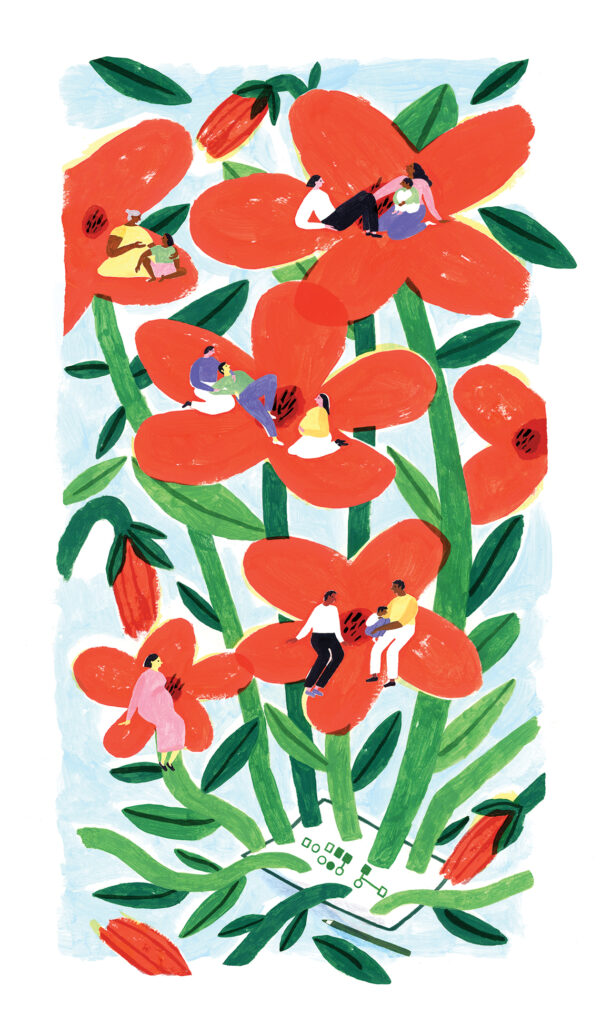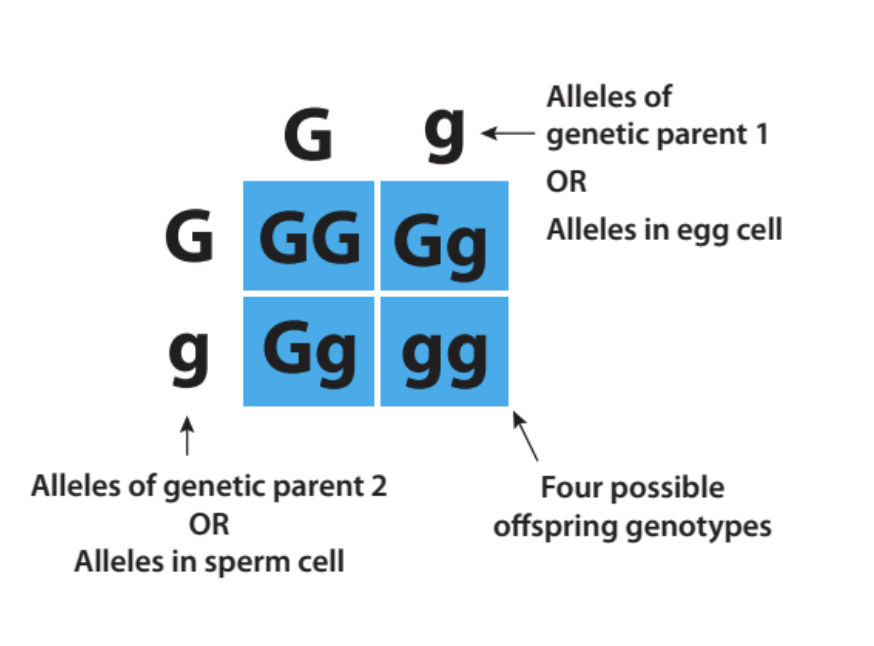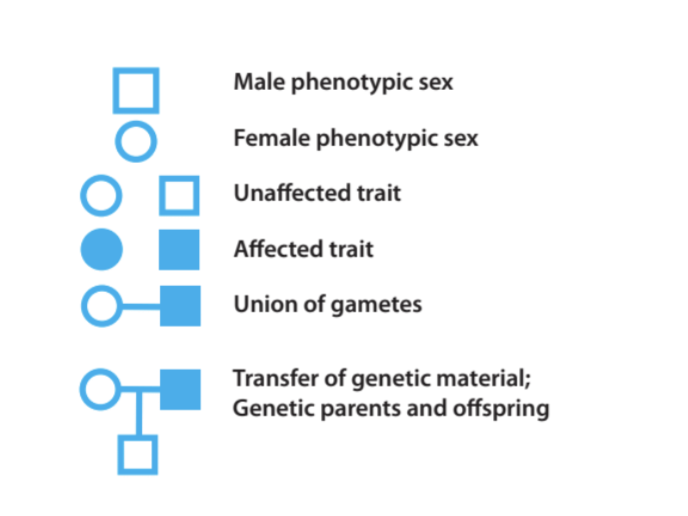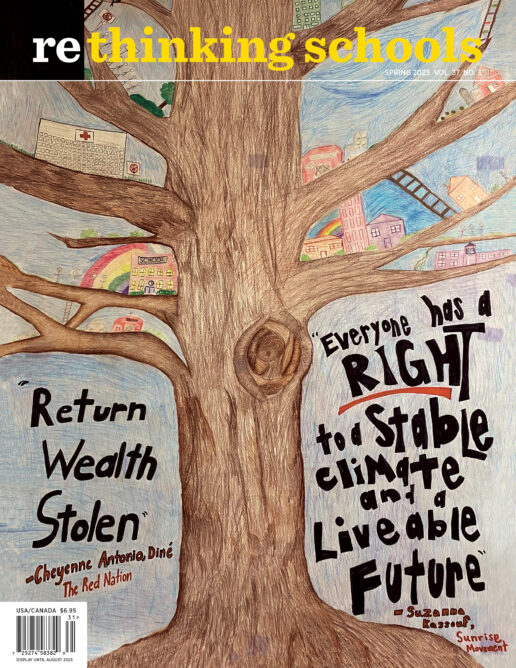What Is a Family?
Inclusive Teaching About Genetics and Reproduction in K–12 Life Sciences
Illustrator: Frances Murphy

Every year I teach biology, I pass out a student activity sheet with a diagram of an egg and a sperm on it. I say, “Good morning, class. Today we begin a new unit!” One of my 9th graders will glance at the paper, groan, and say, “We already learned this in middle school.”
I’ve heard it a million times. Indeed, reproduction is a perennial topic in life science curricula. In the Next Generation Science Standards, some of the earliest disciplinary core ideas for K–3 are about organisms reproducing, resembling their parents, and forming groups to survive. These fundamental ideas come back year after year as older students delve deeper into heredity, evolution, and anatomy. But too often, we teach and perpetuate a scientific concept of reproduction detached from students’ social identities and their diverse families.
Without a more inclusive lens, students disengage and feel left out of science. I felt this myself as a young transgender boy in a high school biology class. We were taught that “The father contributes the sperm to make the child,” and “To have fitness, an individual must successfully pass on their genes.” I rolled my eyes and slouched back in my seat. I knew I would do neither of these things in my lifetime, but I still considered myself to be a valuable part of humanity, a man, and maybe someday a father. And I knew I wasn’t alone — many of my peers did not fit into these oversimplified statements for one reason or another: students with two moms or two dads, those born from surrogacy, adoptees, students in foster care, students with transgender and nonbinary parents, and those with no intention to have children.
Life science education must shift to include more diverse representations of human behavior and human families. This is necessary to achieve a more accurate view of the living world, to honor student identities, and to prepare young people to live in a world where conversations about gender constantly grow and change. Here, I share some strategies that I use to make this shift.
Multiple Concepts of Family
Early in the year, I reserve time with my students to recognize the many meanings of “family.” I share a personal story as an example. My mom gave birth to me; we share some of the same genetic material and the same traits. I could call my mom a part of my “genetic family.” Then there’s my dad, who entered my life when I was 3 years old. We are not genetically related, and kids used to say, “That’s not your real dad.” But to me, he has always been my dad. And I say he is a part of my “social family.” Later when he legally adopted me, he became a part of my legal family and he gained certain rights and responsibilities.
I tell my students that I am just one example of how somebody’s genetic, social, and legal concepts of family may differ. Once I have laid out some of the language necessary to discuss these variations, I tell students my expectation that they communicate precisely about families, both in and outside of science class. I expect that students say “girls” when they are talking about everybody who identifies as a girl, and they say “people
with ovaries” when the discussion is only pertinent to having ovaries.
Some students are eager to share about their family structures when it comes up at some point in the year. Lucas presented a research project about androgenetic alopecia where he shared his thoughts about his own risk of early hair loss. He said to his class, “I have two moms, and I’m only genetically related to my birth mom. Her side of the family never seems to lose their hair. Then last year I got to meet my sperm donor, and he still has all of his hair. So I think I’m at a low risk for hair loss. You might be at risk if lots of your genetic relatives lost their hair early.”
Precise language empowers students to share as much or as little as they choose about their lives, while still being included by default in generalized conversations about reproduction.
Sexual, Reproductive, and Parenting Behaviors
One year when I was teaching a lesson on natural selection, Kiera raised her hand and asked with a giggle, “What about gay people?”
I said, “Great question.” But when I started to address the topic, Kiera said, “OK, I was just kidding.”
I said, “Just kidding? There are researchers spending their lives trying to better understand your question!”
She was new to my class for the second semester and she hadn’t expected a teacher to entertain a question about gay people. In conversation, I found that Kiera, like many young people, was educated to think of sex, reproduction, and parenting as fused behaviors. That is, your parents are the two people who raise you, and they also contributed the genetic material to make you, and they achieved this through sexual intercourse. If you think of it like that, then the only type of sexual behavior with any scientific significance is the kind of sex that leads to fertilization. And if you think of it like that, the people who contributed the genetic material should be the only ones to raise and care for the child. And anyone unable or unwilling to reproduce in this way is not worth talking about in science.
But reality is more complex. To begin, I remind students that natural selection is a process that acts on a population, not an individual. If a behavior helps the population to pass on genes, that behavior can be expected to persist in the population, even if it does not bring reproduction for each and every individual. Distinct from reproductive behaviors, humans and animals also engage in sexual behaviors that do not result in fertilization, including same-sex sexual behavior. These behaviors have an energy cost but they have persisted for many generations, so they must have a beneficial or at least neutral effect on the overall fitness of a population. The Soliloquy video “Why Does Homosexuality Evolve?” outlines several hypotheses, such as the Inclusive Fitness hypothesis, which states that a gene for same-sex attraction will persist in a population because even though homosexual individuals are less likely to reproduce themselves, they provide significant care to the children in their extended families, with whom they share some genes (see Resources). The video also distinguishes sex and reproduction from a third type of behavior, parenting or caregiving behaviors. These acts, which increase the survival rate of an existing offspring, can be performed by the genetic parents, (gay) extended family, or other members of society.
Students can practice distinguishing diverse behaviors using River Suh’s Queer Species Database, based on Joan Roughgarden’s book Evolution’s Rainbow (see Resources). This database includes phenomena like all-female lizard reproduction and fish who change sex during their lifetime. In some years I challenge students to classify each phenomenon in the database as reproductive behavior, sexual behavior, parenting behavior, or some combination. Students can also construct explanations for how non-reproductive behaviors may still confer increased fitness. For example, I have asked my class to explain why male-male swan couples who adopt an egg have greater parenting success than male-female couples. After reading a short article that gives no hypothesis for this difference in parenting success, one student proposed, “Maybe the males could use their larger bodies to defend the egg from threats.” Another suggested, “The male-male couple can’t become pregnant again in the future, so they can devote more energy to raise the one baby.” After hearing and honoring a wide range of hypotheses, I revealed the conclusion of researchers who observed the swans: Male-male couples succeeded as parents due to better access to nesting sites and a more equitable workload.
The study of animal behavior confirms and amplifies a key message for the humans in my classroom: Your sexuality is valid, you can be a parent without having a genetic relation to your child, and you don’t have to reproduce for your life to have value. I repeat this message several times to rebut the dangerous idea that our worth as humans is tied to our evolutionary fitness.
Models of Heredity
As I started my Genetic Inheritance unit, Freddy was one of my students who cried “I already learned this in middle school!” So I asked him to use a Punnett square to predict the offspring of a mating between two humans using a pattern of simple dominance. A Punnett square is a graphic organizer used to list out possible combinations of genes that an offspring could inherit. Freddy wrote out the parental genotypes flawlessly and transferred the symbols to fill in the boxes for the possible offspring. I overheard him explaining the process to his table partner: “See these letters outside of the boxes? That’s the mom and that’s the dad.”
“Really?” I said. “That’s the mom? It looks like a bunch of letter G’s to me.”
Freddy said, “Well, it’s not the mom, but the G stands for her genes, which is the thing that matters in this question.” That got me thinking about how we would phrase it in our notes the next week. I knew that not everybody has two people they call mom and dad, who are the same people who transferred genes to them. And if we were going to draw a generalized model of heredity, it had to be broad enough to include everybody — every human and every other living thing.
I settled on the lengthy but intentional labels “Alleles of genetic parent 1” and “Alleles of genetic parent 2.” As we took notes, I told my students, “You might have learned to call them just ‘mom’ and ‘dad,’ but is that inclusive? Does everybody receive their alleles, meaning their copies of genes, from their mom and dad? Our social concept of parents might be different from our genetic relations. And sometimes we need to do a Punnett square for, say, mosquitos! They don’t have a social concept of a parent at all — the offspring just hatch from their eggs and fend for themselves. So we’re writing down general language that makes sense for any case of sexual reproduction.”

For some learners, the graphic of the Punnett square implies two parents uniting. I reminded the class that sometimes those two people don’t physically come together, it’s only the alleles inside their sex cells that unite. Humans do this when they use assistive reproductive technology; some animals and all plants use external fertilization. So I added an alternate set of labels to our notes: “Alleles in egg cell” and “Alleles in sperm cell.” Students learning this concept for the first time received inclusive and accurate language to describe inheritance. And students like Freddy, with prior exposure to the model, seemed to readily understand these refinements. I was pleased to hear them start communicating with more precise terms like “allele” and “genotype” rather than “mom” and “mom’s letters.”
A few weeks later, when we got to pedigree charts, precise and inclusive language again proved essential. Since most pedigrees are drawn after macroscopic observations and not DNA testing, we labeled the square as “male phenotypic sex” and the circle as “female phenotypic sex.” We designated the shaded-in shapes to mean an “affected trait” rather than “diseased” or “mutant” traits, so our key could apply broadly to everything from red hair to retinoblastoma.
To describe the relationships between individuals on the pedigree, we had to consider what was not represented. From a non-scientific perspective, a pedigree chart looks like a family tree, and a horizontal line between two people implies a marriage. But in a genetic pedigree, the horizontal line does not mean they were married, had sexual intercourse, or even met — the line only guarantees that a union of gametes took place. And a vertical line may look like a couple “having kids,” but in a pedigree the line does not denote a family unit in a social or legal sense — the line only represents a transfer of genetic material between genetic parents and their offspring.

After the class became familiar with the pedigree chart, I said, “Remember that a pedigree is only a model of the real world. What are its limitations? What are some family situations that a pedigree cannot represent?”
Students needed no coaxing to respond; they drew from experience.
“Sperm donors and egg donors. And surrogate mothers — they aren’t genetically related to the baby, but they still carried it.”
“My adopted sister. There’s no way to show the tightness of our bond on this model.”
“My mom had a miscarriage. We don’t know what traits the baby had, but we would still want our model to include him.”
I allowed students to suggest additional symbols to represent a broader range of family stories. Many enjoyed creating new visual language, and in the process, they thought of blended families, half-siblings, divorced parents, foster families, intersex people, and even more situations that might need representation. We built the consensus that a pedigree is not a family tree, and although it represents the transfer of a particular genetic trait, it never fully represents anybody’s family story — not their genetic, social, nor legal family.
That was our last day in class with pedigrees, but I went home and did more research. The earliest pedigree charts were used to track the “purity” of nobility bloodlines in England. Pedigrees were later adopted to breed animals and plants, enabling the agricultural revolution. The practice also outed early transgender people and, more notoriously, bolstered eugenics beliefs in Nazi Germany. Nazis used pedigree graphics to classify a person as Jewish, Mixed, or German ancestry under the Nuremberg Laws, as well as to forbid certain mixed marriages. Today, health care professionals use pedigrees to take a family history and to give their patients the best possible advice.
Next year, I hope to give my students more opportunity to understand the complex history of pedigrees. I want them to know that the pedigree is just one way to model genetic relationships, and it is not a socially benign or neutral tool. I plan to ask my students, “How can we reconcile the utility of this model with its role in historical injustices?”
Moving Forward with Inclusive Science
I’ve enjoyed success in teaching inclusive genetics and reproduction in my own classroom, and I share my strategies with other educators through workshops and on my website. But this work has also drawn criticism. Although detractors frame my language as overly “politically correct,” I frame it as an acknowledgement and honoring of all students and their stories. Critical voices have tried to incite outrage by saying that when I tell a class “People with ovaries produce egg cells,” this somehow means I am erasing the word “women.” But we do use the word “women” in our science class — when talking about people who are women. We don’t say “Women produce egg cells” as a defining rule, just like we don’t say “Tall people have brown hair” — it’s simply not true all the time.
Any educator who makes inclusive shifts in their science curriculum must anticipate and respond to pushback. On the Gender-Inclusive Biology website, we have compiled responses to common criticisms (see Resources). If somebody is concerned that teaching about gender is not in the curriculum, we point to the Next Generation Science Standards (NGSS), which specify that science teachers must use effective strategies to include students of different gender backgrounds. If somebody claims that these topics are not appropriate for younger grade levels, we highlight the fact that children recognize, explore, and learn about gender at every age — whether we teach it explicitly or not. We encourage teachers of the younger grade levels to work alongside their school’s health educators to align the language and concepts taught in health and science.
In my classroom, I see students grow into better humans every year. By May, I hope that they understand why diversity is an important part of science and society. Although not every student uses inclusive language all of the time, they have an awareness. They know that when somebody corrects their language or asks for clarification that it’s about inclusion, not just about “offending people” or “getting in trouble.” I don’t try to shield my students from certain words forever — I know that Lucas, who has two moms, will see antiquated language on standardized exams and in college. But now he is better equipped to challenge that language, and he knows that there is a place for him in the sciences.
Not every student can receive the same level of inclusive education that I provide in my classroom, at least not while public education is in the political crosshairs, and curriculum bills threaten to intimidate and undermine educators. I have spoken to teachers whose goals are to swap out just a few words in their genetics unit — a change from “men” to “testes” is all they feel safe doing in their school. But that small change makes a big difference for students who are listening. And I notice small changes outside of schools; more and more conversations about abortion frame it as a “reproductive right” instead of strictly a “woman’s right.” I am excited for a future where life science education is relevant and empowering for all students. The living world has always been rife with diverse behaviors, bodies, and families — it is our duty to teach it. l
Resources
Elementary
Gender-Inclusive Classrooms Booklist
A teacher-curated booklist including many titles that feature diverse families. bit.ly/3Iqug3w
Gender Showcase K–5
A collection of short scenes about animals with diverse bodies, behaviors, and families.
bit.ly/3YLfAkO
And Tango Makes Three by Justin Richardson and Peter Parnell
(Simon and Schuster, 2005)
An illustrated, fictionalized account of the true story of two male penguins who became partners and raised a penguin chick in the Central Park Zoo.
Tell Me About Sex, Grandma by Anastasia Higginbotham
(The Feminist Press at CUNY, 2017)
An illustrated book for ages 6–12 that teaches that sex is distinct from marriage or reproduction, and sex looks different for everyone.
What Makes a Baby by Cory Silverberg
(Seven Stories Press, 2013)
A book for pre-school to 8 years old about where babies come from, which includes all kinds of kids, adults, and families.
Zak’s Safari by Christy Tyner
(CreateSpace Independent Publishing Platform, 2014)
An illustrated book about donor-conceived kids of two-mom families, for ages 4–8 and available to read online in English, Spanish, and French.
Secondary
The Allusionist podcast episode “Parents” by Helen Zaltzman
A 45-minute discussion with trans parents about the language of pregnancy, birth, and parenting. bit.ly/3jWseia
Animal Lives by Humon Comics
An illustrated collection of 33 ways that animals have sex, reproduce, parent, and form families.
bit.ly/3YPpT7t
Diagram of Human Reproductive Process
A diagram that I adapted early in my teaching career to show the chromosomes and cells involved in meiosis and fertilization for humans. bit.ly/3RYwZ7k
“Evolution’s Rainbow: A Queer Species
Database of 200+ Organisms” by River Suh, based on Joan Roughgarden’s Evolution’s Rainbow: Diversity, Gender, and Sexuality in Nature and People (University of California Press, 2013).
Gender-Inclusive Pedigree Charts
Guidance on how to teach about pedigree charts with inclusive language, appropriate framing, and historical context. bit.ly/3Yy17ZJ
Inclusive Genetics Activities by Elizabeth Duthinh
Five activity sets using inclusive language and premises, developed by a high school teacher and physician. bit.ly/3KcBV6O
Pigeonetics Game by the University of Utah Genetic Science Learning Center
Students learn patterns of genetic inheritance in a game that accurately portrays sex and reproduction in animal species without conflating sex with gender or imposing human gender stereotypes. bit.ly/3xlNUHN
Secrets of the X Chromosome by Robin Ball
A TedEd video lesson using nuanced language and visuals to discuss the human X chromosome.
bit.ly/3YxI3uQ
Soliloquy. Why Does Homosexuality Evolve? Youtube video. youtube.com/watch?v=UsX2vfFNPak
“What Makes a Baby”: 8th-grade edition
Lewis Steller’s adaptation of Cory Silverberg’s book for 8th-grade students. In this forthcoming Rethinking Schools article, Steller shares a process of inviting student-created language to discuss genetics and reproduction.
K–12 Materials
Drops Visual Dictionary
A web and mobile tool to facilitate talking about gender, sex, reproduction, and families with students who are learning English. bit.ly/3xoesIc
Gayby Baby School Action Toolkit
A documentary film about same-sex parented families with a separate school resource kit for primary and secondary students. The poster “There’s More than One Way to Make a Family” can be useful for all classrooms. bit.ly/3Z94JSb
Gender-Inclusive Biology Language Guide
A comprehensive and living guide to talking about gender, sex, and sexuality in K–12 science contexts. bit.ly/3lwlVSR
Queerspawn Resource Project
A collection of resources that reflect the complex, authentic, and intersectional experiences of people with one or more LGBTQ+ parents/guardians.
bit.ly/3I4t8ky

